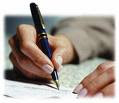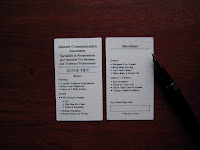
I was on a sales call with one of my colleagues last June. As we drove away in the taxi, he ridiculed my note taking during the call (it was his customer) and bragged about his good memory. He said “Look, if I am taking notes, I am not focusing 100% on what the customer is saying.” This arrogance can cost you. Rule #1: Take good notes.
My colleague’s misguided confidence in his IQ and memory reminded me of Jeffery Fox’s book: Secrets Of Great Rainmakers. In the book, Fox tells a story about waiters who write down their customer’s orders vs. those who don’t and the differences in the gratuity each receives as a result. The waiter who writes down the order earns significantly more in tips. Why? The waiter, who thought he was impressing the customer with his great memory, was really making the customer anxious and uncomfortable. Deep down, the customer was worried that the waiter might not get it right and if he did blow the order, the customer was especially annoyed because the error was preventable. So it goes with a sales call.
When the customer is talking and you are taking notes, the customer is feeling more valued. The fact that you are writing it down, in detail, makes the customer feel that what he or she is telling you is important.
Taking notes signals to the customer that you are a professional and that you are organized. By the way, invest in a high quality portfolio and spend a few hundred dollars on a good pen. I use a Raika sewn bound leather portfolio with gold-edged ruled pages and a Montblanc rollerball pen. Make an impression.
Taking notes helps sharpen the customer’s mind. When the customer knows you are writing it down, she will subconsciously work harder on getting you more detail and greater accuracy in the information she is transmitting. I have seen customers pick up the phone and call other departments to get me more detail during a call. Wow! They WON’T do that if you are just sipping coffee, nodding attentively, and making eye contact.
Taking notes also gives you a great way to summarize as you close out the call. You really focus the customer when you say “let me review my notes with you and make sure I have this requirement clearly understood.” Then, take the customer through what you have written down ... point by point. Finish with “Did I miss anything? Was there anything else you wanted to cover with me?”
Here is a final excellent reason to take good notes. You can re-play the sales call later, in the solitude of your hotel room, and discover fresh insights that maybe you missed on the first pass. You can triangulate with notes you made from a previous call with another executive in the same company. You can share the notes with your team and see what new ideas the notes stir up in their minds. Here is another one. When I refill my Raika, I make a point of re-reading every page of the old diary. Without fail, I find something I missed, an action or request that I need to follow up on, or a note that at the time, seemed unimportant, but now, in light of new developments in the account, are key to achieving my objective and closing a big sale.
Look, if for no other reason, because a lot of amateur salespeople never take notes, you will immediately stand out from your competitors by doing it.
Good Selling!!
